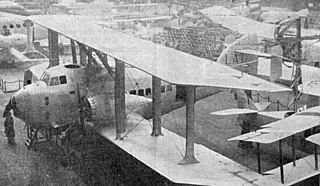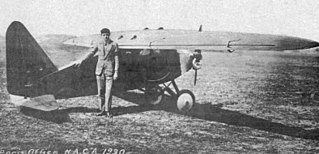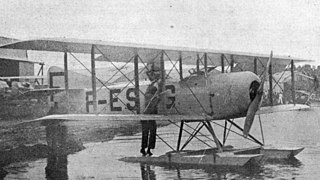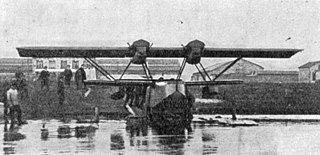Design and development
Yves Le Prieur had identified a need for a simple, economical training aircraft on which pupils could master the behaviour of seaplanes and approached the designer and constructer Louis Peyret for a suitable aircraft. The outcome was the Peyret-Le Prieur seaplane. [1] [2]

A seaplane is a powered fixed-wing aircraft capable of taking off and landing (alighting) on water. Seaplanes that can also take off and land on airfields are in a subclass called amphibious aircraft. Seaplanes and amphibians are usually divided into two categories based on their technological characteristics: floatplanes and flying boats; the latter are generally far larger and can carry far more. These aircraft were sometimes called hydroplanes, but currently this term applies instead to motor-powered watercraft that use the technique of hydrodynamic lift to skim the surface of water when running at speed.
It was a single bay biplane, with rectangular plan wings mounted without stagger and braced by two pairs of parallel, vertical interplane struts and bracing wires, with a large interplane gap of 1.90 m (6 ft 3 in). The wings were wooden, two-spar, two-part structures, with spruce leading edges. Broad, full-span ailerons on upper and lower wings were externally connected. [1]

In a fixed-wing aircraft, the spar is often the main structural member of the wing, running spanwise at right angles to the fuselage. The spar carries flight loads and the weight of the wings while on the ground. Other structural and forming members such as ribs may be attached to the spar or spars, with stressed skin construction also sharing the loads where it is used. There may be more than one spar in a wing or none at all. However, where a single spar carries the majority of the forces on it, it is known as the main spar.

A spruce is a tree of the genus Picea, a genus of about 35 species of coniferous evergreen trees in the family Pinaceae, found in the northern temperate and boreal (taiga) regions of the Earth. Spruces are large trees, from about 20–60 m tall when mature, and have whorled branches and conical form. They can be distinguished from other members of the pine family by their needles (leaves), which are four-sided and attached singly to small persistent peg-like structures on the branches, and by their cones, which hang downwards after they are pollinated. The needles are shed when 4–10 years old, leaving the branches rough with the retained pegs. In other similar genera, the branches are fairly smooth.
The seaplane had a rectangular section fuselage, built around four longerons and plywood covered. It was widest under the wing leading edge, where on each side a vertical cabane strut joined the upper longeron to the forward spar, and where pupil and tutor sat side-by-side in an open cockpit. The short nose ahead of them remained wide and the engine, unusually, was mounted off-set to port. Initially a 12 kW (16 hp) four-cylinder inline Sergant A was used, its radiator mounted midway up the portside cabane strut. At the rear the large area empennage was conventional, with a large span, rectangular plan all-moving tail mounted on top of the fuselage. Its triangular fin carried a roughly rhomboidal rudder which reached down to the keel through an elevator cut-out. [1]

The fuselage is an aircraft's main body section. It holds crew, passengers, and cargo. In single-engine aircraft it will usually contain an engine, as well, although in some amphibious aircraft the single engine is mounted on a pylon attached to the fuselage, which in turn is used as a floating hull. The fuselage also serves to position control and stabilization surfaces in specific relationships to lifting surfaces, which is required for aircraft stability and maneuverability.

Plywood is a material manufactured from thin layers or "plies" of wood veneer that are glued together with adjacent layers having their wood grain rotated up to 90 degrees to one another. It is an engineered wood from the family of manufactured boards which includes medium-density fibreboard (MDF) and particle board (chipboard).

A cockpit or flight deck is the area, usually near the front of an aircraft or spacecraft, from which a pilot controls the aircraft.
The seaplane had simple, rectangular cross-section floats. The flat undersides curved up towards the nose, reaching just beyond the propeller and the aft ends were under the ailerons. There was no step. Each float was attached with four aluminium tube struts, two leaning inwards to the lower fuselage longeron and two outwards to the wing spars. They were constructed of wood, with ash frames and mahogany plywood covering. The tail was protected with a cylindrical float of the same construction, attached longitudinally under the fin. [1]

In aeronautics, a propeller, also called an airscrew, converts rotary motion from an engine or other power source into a swirling slipstream which pushes the propeller forwards or backwards. It comprises a rotating power-driven hub, to which are attached several radial airfoil-section blades such that the whole assembly rotates about a longitudinal axis. The blade pitch may be fixed, manually variable to a few set positions, or of the automatically-variable "constant-speed" type.

A strut is a structural component commonly found in engineering, aeronautics, architecture and anatomy. Struts generally work by resisting longitudinal compression, but they may also serve in tension.

Fraxinus, English name ash, is a genus of flowering plants in the olive and lilac family, Oleaceae. It contains 45–65 species of usually medium to large trees, mostly deciduous, though a few subtropical species are evergreen. The genus is widespread across much of Europe, Asia, and North America.
Fitted with the Sergant engine, the seaplane began tests on Lake Annecy in the summer of 1924 but it was unable to reach water speeds fast enough to unstick. In response a 34 kW (45 hp) Anzani 6 radial engine was substituted, [2] again mounted off-set. [3] With this, the seaplane left the water easily on its first flight on 24 August 1924. [4] Further tests showed that about 19 kW (25 hp) was required for take-off, though once in the air, 11–15 kW (15–20 hp) was enough. [2] By mid-September nineteen flights had been made, some lasting about 30 minutes, and a passenger had been carried. The seaplane then returned to Paris, where it was fitted with a wheeled undercarriage for further tests, [3] though by January 1925 it was flying from water again, at Pecq. [5]
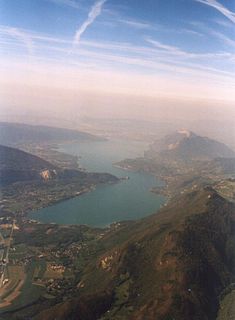
Lake Annecy is a perialpine lake in Haute-Savoie in France.

The radial engine is a reciprocating type internal combustion engine configuration in which the cylinders "radiate" outward from a central crankcase like the spokes of a wheel. It resembles a stylized star when viewed from the front, and is called a "star engine" in some languages. The radial configuration was commonly used for aircraft engines before gas turbine engines became predominant.

Paris is the capital and most populous city of France, with an area of 105 square kilometres and an official estimated population of 2,140,526 residents as of 1 January 2019. Since the 17th century, Paris has been one of Europe's major centres of finance, diplomacy, commerce, fashion, science, and the arts.
By September 1924 the aircraft was judged a success and a second was under construction. Le Prieur had plans for a floatplane flying school at Annecy. [3] It is not known if the second machine was completed or the school set up.
This page is based on this
Wikipedia article Text is available under the
CC BY-SA 4.0 license; additional terms may apply.
Images, videos and audio are available under their respective licenses.














